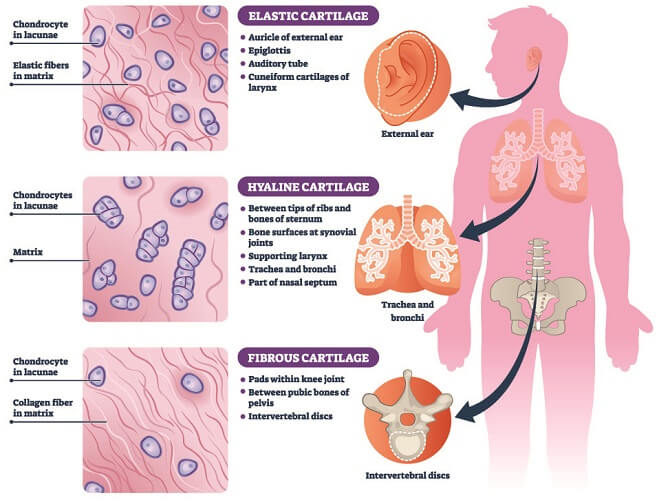Seriously! 30+ List On Connective Tissue Types Pictures Your Friends Did not Tell You.
Connective Tissue Types Pictures | Connective tissue is the tissue that connects, separates and supports all other types of tissues in the body. These structures help attach muscles to bones and link bones together at joints. Connective tissue supports other tissues and binds them together (bone, blood, and lymph tissues). The body has a lot of connective tissues and they are distributed throughout the body. It supports, surrounds, strengthens, stores energy for, cushions and protects the components of your running body.
Connective tissue is exactly what it sounds like: Find the perfect dense connective tissue stock photos and editorial news pictures from getty images. 60 pictures of ten types of connective tissues learn with flashcards, games, and more — for free. Both have a matrix composed mainly of collagen fibers, although dense regular tissue has a. Cartilage is a connective tissue, it is more flexible than bone but tough.

Connective tissue is one of the four types of tissue in traditional classifications (the others being epithelial, muscle, and nervous tissue.) it is characterized by abundant extracellular matter (intercellular substances and fibers) encasing relatively few cells. Also, these tissues perform other function blood. Cartilage is associated with bone for the most part and stops the bones from rubbing against each other and wearing away. It varies in types and distributed in various parts of the body. Connective tissue is made up of a small fraction of cells and a majority of extracellular substance which keeps the cells separated. 60 pictures of ten types of connective tissues. Learn vocabulary, terms, and more with flashcards, games, and other study tools. It develops from the mesoderm. Of all types of tissues in the body, the connective tissue is the most abundant. The diagram below describes the three types of cartilage, basically each of the types has a different. The body has a lot of connective tissues and they are distributed throughout the body. It supports, surrounds, strengthens, stores energy for, cushions and protects the components of your running body. Start studying connective tissue types (pictures).
However connective tissue differs from other types in that its cells are loosely, rather than tightly, packed within the ecm. Cartilage is a connective tissue, it is more flexible than bone but tough. The two types of cells found in connective tissue. Connective tissue is the tissue that connects, separates and supports all other types of tissues in the body. Terms in this set (65).

Explain the functions of connective tissues. Also, these tissues perform other function blood. In this area note the irregular, wavy collagen fibers arranged singly or in small groups. 3 question 4 what type of connective tissue? It's the glue that holds you together. Connective tissues are specialized tissues, which provide support and hold the body's tissues together. There are many different kinds, and they mainly serve dense connective tissue is divided into regular and irregular types. Distinguish the connective tissues from all epithelial tissues on the basis of location, cell density and the presence of discrete fibers. Connective tissue, epithelial tissue, muscle tissue, and nervous tissue. Each connective tissue acts to support and hold your body together and, in some instances, transmit substances. Connective tissue has relatively few cells separated by a large amount of extracellular matrix (as opposed to epithelial tissue which exhibits high cellularity). Dense connective tissue is composed of large amounts of closely packed collagenous fibers. Connectivetissuetechniques.org is an educational organization.
In addition, they nourish and. Connective tissue is classified as loose or dense connective tissue depending on the ratio and structure of its components. 3 question 4 what type of connective tissue? Banner with different types of connective and soft tissues, sign with tumor and yellow ribbons promoting awareness and support for international sarcoma awareness day this 13th july. The three main types of cartilage tissue are hyaline cartilage, fibrocartilage, and elastic cartilage picture shown is of compact bone tissue.

Epithelial tissue provides a covering (skin. 60 pictures of ten types of connective tissues learn with flashcards, games and more — for free. The two types of cells found in connective tissue. Connective tissue is one of the four types of tissue in traditional classifications (the others being epithelial, muscle, and nervous tissue.) it is characterized by abundant extracellular matter (intercellular substances and fibers) encasing relatively few cells. Connective tissue is one of the four traditionally classified types of biological tissue. It serves to connect and support other tissues and also has regulatory and immunologic functions. Connective tissue has relatively few cells separated by a large amount of extracellular matrix (as opposed to epithelial tissue which exhibits high cellularity). There are many different kinds, and they mainly serve dense connective tissue is divided into regular and irregular types. As the name suggest connective tissue is a tissue that connects the different cell and structure of the body. There are 4 basic types of tissue: Tissue that connects your body's muscles, organs, blood vessels, nerves and other parts to one another. Learn vocabulary, terms, and more with flashcards, games, and other study tools. Based on the cells present and the ecm structure, we differ two types.
Connective tissue is one of the four traditionally classified types of biological tissue connective tissue types. Each connective tissue acts to support and hold your body together and, in some instances, transmit substances.
Connective Tissue Types Pictures: Look at the connective tissue in the submucosa which is the lighter staining area view image between the intestinal epithelium and the smooth muscle layer.
Source: Connective Tissue Types Pictures
0 Response to "Seriously! 30+ List On Connective Tissue Types Pictures Your Friends Did not Tell You."
Post a Comment